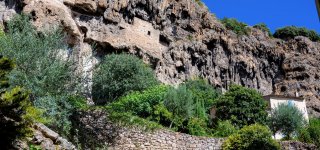Troglodyte village of Cotignac
unique village built against a tuff cliff, Cotignac is partially troglodyte. The site has an almost unreal scenery, between medieval town, typical Provençal houses and cliff inhabited. Perle du Var Cotignac is a tourist destination but also an important place of pilgrimage.
With 400 meters long and 80 meters high, the Cotignac tufa rock acts at the same time support to cave dwellings carved into the rock and natural protection to the medieval village nestled at his feet.
In the Quaternary, these are huge waterfalls in the course of the Cassole, a tributary of the Argens, who formed the tuff, rocky crevices of the cliff and concretions adorning. The fortifications in the rock and watch towers were built to protect the village and its inhabitants during times of invasion. The cave dwellings could accommodate the villagers during the Saracen attacks, and even house flocks.
If the caves are formed naturally in the rock under the effects of water, the traces of human intervention to develop them are still visible: the tuff has been dug in places, the wall covered with lime to limit the humidity. Terraces were also built, as well as staircases and fireplaces. The caves used as shelter for farm animals still carry remnants of feeders. A pigeon has even been arranged in the cavities.
The large rock of Cotignac has long served extraction quarry for stones for building the houses and buildings of the village. The career of Cotignac was active until the 19th century.
At the top of the rock, both ancient square towers date back to the beginnings of feudalism. Their remains still majestically dominate the decor of Cotignac. The castle belonged to the 11th century at Lord Boniface de Castellane, before passing into the hands of the counts of Provence. The parish church, already present in the 12th century, is then attached to the Benedictine abbey of Saint-André Villeneuve-es-Aveyron. The top of the rock is still planted olive trees whose culture has long been the main economy of the village.
In the heart of preserved and restored medieval town with care, the remains of the castle are home to exhibitions. Destroyed after World War II, the building is topped with a charming outdoor theater. The site has however experienced a prestigious past: he was especially Louis XIV and his court in 1660, when the chief began his pilgrimage to the chapel of Our Lady of Graces.
Sanctuary dedicated to the Virgin, the Chapel of Graces Cotignac Notre Dame is still a place of pilgrimage attractive. Built in the 16th century, it was the scene of several holy apparitions recognized by the Church. Louis thinks duty birth to the wish that his mother Anne of Austria had been formulated. Shrine full of history, the Chapel of Our Lady of Grace is associated with St. Joseph monastery Bessillon, also located in Cotignac: it houses a miraculous source said.
In the center of Cotignac finally the main course shaded by plane trees is a pleasant place to stroll and linger. The street, lively and festive, home to shops, restaurants and friendly cafés. The whole village comes alive in the season of craft markets, flea markets, markets of potters and cultural festivals: outdoor cinema, theater and concerts.
